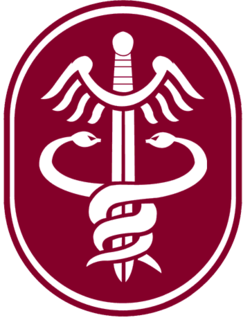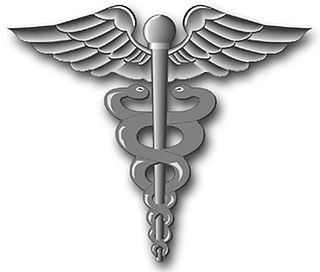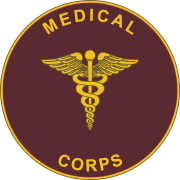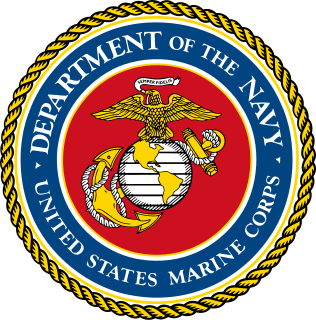
The U.S. Army Medical Command (MEDCOM) is a direct reporting unit of the U.S. Army that formerly provided command and control of the Army's fixed-facility medical, dental, and veterinary treatment facilities, providing preventive care, medical research and development and training institutions. On 1 October 2019, operational and administrative control of all military and veteran medical facilities transitioned to the Defense Health Agency.

A medic is a person involved in medicine such as a medical doctor, medical student, paramedic or an emergency medical responder. Among physicians in the UK, the term "medic" indicates someone who has followed a "medical" career path in postgraduate professional training accredited by a College of Physicians, such as cardiology or endocrinology, in contrast to a surgical branch of specialisation accredited by a College of Surgeons.
The Fleet Marine Force Warfare Insignia, also known as the Fleet Marine Force badge or FMF pin, are three military badges of the United States Navy which are issued to those U.S. Navy officers and sailors who are trained and qualified to perform duties in support of the United States Marine Corps. There are currently three classes of the Fleet Marine Force pin, being that of enlisted, officer, and chaplain.

The Medical Corps of the United States Navy is a staff corps consisting of military physicians in a variety of specialties. It is the senior corps among all staff corps, second in precedence only to line officers. The corps of commissioned officers was founded on March 3, 1871.

The Dental Corps of the United States Navy consists of naval officers who have a doctorate in either dental surgery (DDS) or dental medicine (DMD) and who practice dentistry for Sailors and Marines to ensure optimal oral health.

The Combat Medic/Healthcare Specialist is responsible for providing emergency medical treatment at a point of wounding in a combat or training environment, as well as primary care, and health protection and evacuation from a point of injury or illness. Additionally, medics may also be responsible for the creation, oversight, and execution of long-term patient care plans in consultation with or in the absence of a readily available physician or advanced practice provider. Combat medics may be utilized in hospitals and clinics where they have the opportunity to work in additional roles such as operating medical and laboratory equipment, performing and assisting with procedures, and beyond.

A hospital corpsman is an enlisted medical specialist of the United States Navy, who may also serve in a U.S. Marine Corps unit. The corresponding rating within the United States Coast Guard is health services technician (HS).

The Army Medical Department of the U.S. Army (AMEDD), formerly known as the Army Medical Service (AMS), encompasses the Army's six medical Special Branches. It was established as the "Army Hospital" in July of 1775 to coordinate the medical care required by the Continental Army during the Revolutionary War. The AMEDD is led by the Surgeon General of the U.S. Army, a lieutenant general.

The Medical Corps (MC) of the U.S. Army is a staff corps of the U.S. Army Medical Department (AMEDD) consisting of commissioned medical officers – physicians with either an M.D. or a D.O. degree, at least one year of post-graduate clinical training, and a state medical license.
The Health Professions Scholarship Program (HPSP) offers prospective military physicians, dentists, nurse practitioners, physician assistants, optometrists, psychologists, pharmacists, and veterinarians a paid medical education in exchange for service as a commissioned medical department officer. Programs are available in the United States Army, the United States Navy, and the United States Air Force.

William Richard Charette was a United States Navy master chief hospital corpsman who received the nation's highest military decoration for valor, the Medal of Honor. He was awarded the medal for heroic actions "above and beyond the call of duty" on March 27, 1953, while assigned to a Marine Corps rifle company during the Korean War. He retired from the Navy after 26 years of service.

The United States Fleet Marine Forces (FMF) are combined general- and special-purpose forces within the United States Department of the Navy that perform offensive amphibious or expeditionary warfare and defensive maritime employment. The Fleet Marine Forces provide the National Command Authority (NCA) with a responsive force that can conduct operations in any spectrum of conflict around the globe.

The United States Marine Corps is organized within the Department of the Navy, which is led by the Secretary of the Navy (SECNAV). The most senior Marine commissioned officer is the Commandant of the Marine Corps, responsible for organizing, recruiting, training, and equipping the Marine Corps so that it is ready for operation under the command of the unified combatant commanders. The Marine Corps is organized into four principal subdivisions: Headquarters Marine Corps, the Operating Forces, the Supporting Establishment, and the Marine Forces Reserve.
Naval Hospital Corps School was the United States Navy's only basic hospital corpsman school. It was located within Lake County, Illinois, at 601 D St., Bldg 130H, Naval Station, Great Lakes, Illinois 60088, for nearly a century.

The term military medicine has a number of potential connotations. It may mean:
A headquarters and service company is a company-sized military unit, found at the battalion and regimental level in the U.S. Marine Corps. The U.S. Army equivalent unit is the headquarters and headquarters company.

Rear Admiral Edward Dana Martin is the former Acting Assistant Secretary of Defense. He was appointed to two terms, originally in 1993 and once again in 1997. Martin served as the Secretary's principal advisor on matters related to the military health system, health.mil. The Military Health System (MHS) mission is to provide optimal Health Services in support of the United States' military mission. The MHS is a unique partnership of medical educators, medical researchers, and healthcare providers and their support personnel worldwide. This DoD enterprise consists of the Office of the Assistant Secretary of Defense ; the medical departments of the Army, Navy, Marine Corps, Air Force, Coast Guard, and Joint Chiefs of Staff; the Combatant Command surgeons; and TRICARE providers.

A Special Amphibious Reconnaissance Corpsman (SARC) is a United States Navy hospital corpsman who provides MARSOC and other USSOCOM units advanced trauma management associated with combatant diving and parachute entry. Traditionally, they are attached to the Marine Corps Force Reconnaissance companies to help support the Command Element of the Marine Air-Ground Task Force in special reconnaissance missions.

The Indian Army Medical Corps is a specialist corps in the Indian Army which primarily provides medical services to all Army personnel, serving and veterans, along with their families.
The United States Navy Health Care organization consists of more than 4,300 physicians, 1,200 dentists, 3,900 nurses, and 2,600 administrative, research and clinical specialists. These sailors work on all Navy ships, within Medical Treatment Facilities, and serve on the front lines with Marine Corps Units while providing health care to servicemembers located on bases worldwide. Sailors within Navy Health Care work behind the scenes, as well as on the front lines, to provide physical and mental health care to fellow servicemembers. The men and women in Navy Health Care also provide rapid humanitarian assistance services for people in countries affected by catastrophe or conflict. In addition to providing care to Navy servicemembers and their families, the Navy Health Care Team also supports the Marine Corps, Coast Guard and their dependent populations.













